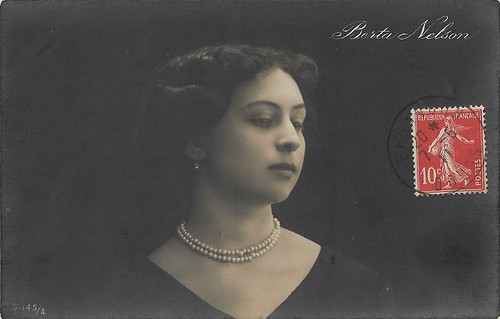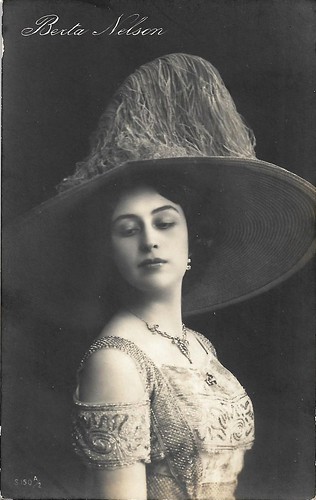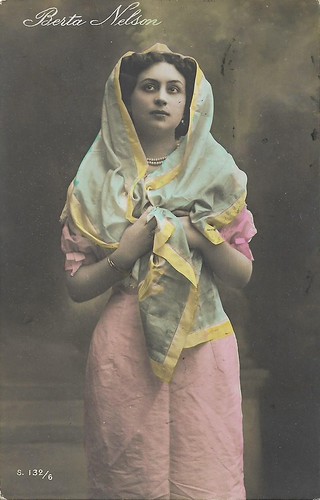
French or Italian postcard, no. S.129/3. The logo on the back of this card is a four-leaf clover, followed by the word "deposé". In correct French, the word "déposé" has an extra accent, but around 1900 French was the language of the elite all over Europe. So this card could come from every European nation (if not using Cyrillic).

French or Italian postcard, no. S.129/4.
Defended against slander
Berta Nelson was born as Berta Katzenelson in Russia, but both her birthdate and birthplace are unknown.
According to an Italian article of 1916, Nelson won beauty contests at a young age. She became an acclaimed soprano and was praised not only for her voice but also for her presence. She was a disciple of the famous Russian opera singer Feodor Chaliapin.
Nelson interpreted 'Manon' and 'Werther' by Massenet, and several Puccini operas, gaining praise in Russia, the Netherlands, Germany, etc. In December 1911-January 1912 for instance, Nelson performed with the local Italian Opera company at the Arts & Sciences building in The Hague. She performed Verdi's 'Trovatore' and Puccini's 'La Bohème' and 'Tosca'.
As occurred with many Russian stage stars, life imitated theatre, so due to his passion for her, a young man from a high-placed family committed an unheard romantic deed. Dutch newspapers wrote in 1913 about a law case in which Nelson was defended against slander by Il Giornale d'Italia.
The story was that of a Neapolitan impresario, madly in love with Nelson, but also a cashier, who had robbed the cash to pay for his extravagant spending to please his beloved, la Nelson. The journalist was condemned to 10 months of prison and the editor to a huge fine, but a court of appeal overruled this and settled the matter with (lower) fines.

Italian postcard, no. S145-4.

Italian postcard, no. S150-A2.
Pursuits by ocean liner, car, and plane
In 1912 Berta Nelson started at the Turinese company Itala Film. She made her film debut in the aviation drama Come una sorella/Like a Sister (Vincenzo Denizot, 1912). Lydia Quaranta played a scorned beloved who as a nurse takes care of her ex, a crashed pilot (Giovanni Casaleggio), while the man's posh mistress (Nelson) dumps him.
In the sensational, daring spy story, Vittoria o morte!/Death and Victory (Vincenzo Denizot, 1913), Nelson had the lead. She pursues a spy who has stolen important papers from her father. Taking an airplane, she manages to get aboard the ocean liner the spy is on, but a fire breaks out on the ship and the spy binds her and flees. With the help of a wealthy American, she manages to steal back the papers and new pursuits by car and plane follow.
Both films were discovered within the Desmet Collection of the EYE Filmmuseum and can be seen on the Desmet playlist on Youtube and on the Museo Nazionale del Cinema playlist on Vimeo.
Other films at Itala were L'ombra del male/The Shadow of Evil (Gino Zaccaria, 1913), Per un bacio a Ninì/Death's Door (N.N., 1913), and Il bacio della zingara/The Gypsy's Kiss (N.N., 1913). At Itala, Nelson's co-actors were Italia Almirante Manzini, Amerigo Manzini, Giovanni Casaleggio and Bonaventura Ibanez.

Dutch postcard by EYE Filmmuseum. Poster by Itala Film for the Italian silent film Vittoria o morte (Vincenzo Denizot, 1913), starring Berta Nelson. Part of the Desmet Collection. Poster design by Leopoldo Metlicovich.
Revenge symbolised by a burning flame
After an intermission of two years, Berta Nelson returned to the screen in 1916 at the Roman Cines company with two films with the ape Jack: L'impronta della piccola mano/Jacko, the Dumb Genius (Enrique Santos, 1916) about an ape trained to steal, and Jack cuor di leone/Jacko, the Lion's heart (Enrique Santos, 1917).
In 1917 Nelson acted as Elena opposite Vittoria Lepanto as Berta in the Dario Niccodemi adaptation L'Ombra/The shadow (Mario Caserini, 1917). The film was much praised by the Italian press at the time.
She played opposite Augusto Poggioli in L'uomo in frak/The man in frak (Nino Oxilia, 1917). Nelson also had a small part in Malombra (Carmine Gallone, 1917), starring Lyda Borelli.
In 1919 Nelson moved to the Film d'Arte Italiana, where she starred in Fiamma simbolica/Symbolic flame (Eugenio Perego, 1920), a film about revenge symbolised by a burning flame. Ugo Gracci had the male lead. This film was also found and restored by the EYE Filmmuseum.
Then followed La casa della felicità/The house of happiness (Ugo Gracci, 1919), Gracci's first film as director, Fascino d'oro/Gold charm (Eugenio De Liguoro, 1919), and Chi l'ha ucciso?/Who killed him? (Mario Gambardella or Alberto Sannia, 1919).
Then Nelson founded her own film company Nelson Film. She made four films with Nelson Film: Come io vi amo/How I love you (Ivo Illuminati, 1921), Sélika (Ivo Illuminati, 1921), and La dama errante/The wandering lady (Aleksandr Uralsky, 1922), a film with many Russian actors. La dama errante was about a gravely ill lady who after losing her betrothed refuses to be cured and starts to get visions, but are they all dreams?
Ali spezzate/Broken wings (Luigi Maggi, 1923) was Nelson's last film. It's about a pharmacist's daughter who flees an arranged marriage. Ali spezzate was already filmed in 1920, and thus must have been the first Nelson Film production, but it was only released in 1923. La dama errante and Ali spezzate were both restored by the Cineteca Nazionale in Rome.

talian postcard, no. S.129/2.

Italian postcard, no. S132-6.
Sources: Vittorio Martinelli (Il cinema muto italiano - Italian), Sempre in penombra (Italian), Delpher and IMDb.
No comments:
Post a Comment